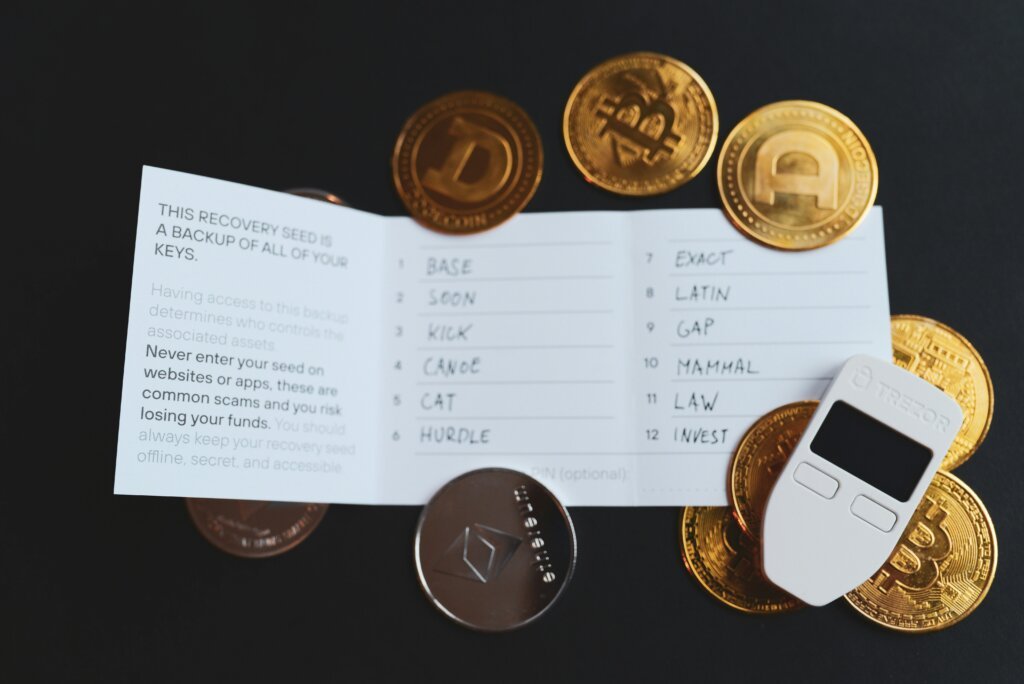How to Store Bitcoin Safely: Wallet Types Explained (Hot Wallets or Cold Wallets)
You’ve bought Bitcoin—now what?
Unlike traditional money, Bitcoin doesn’t sit in a bank account under the watch of financial institutions. Instead, you become your own bank—complete with the freedom, control, and full responsibility that role brings.
This independence is empowering, but it also comes with serious consequences. There’s no branch manager to reset your password, no fraud department to reverse a transaction. If you lose your private keys, your Bitcoin is gone forever. If you send coins to the wrong address or fall for a scam, there’s no customer service hotline that can save you.
Owning Bitcoin is like carrying digital cash in your pocket—it’s yours to spend, store, or secure. But with that power comes the need to protect it wisely.
This guide will teach you:
✔ How Bitcoin wallets actually work (it’s not what you think)
✔ The 5 main wallet types (Hot wallet vs Cold wallet and which is best for you)
✔ Step-by-step security best practices
✔ How to choose between convenience vs. maximum safety
How Bitcoin Wallets Really Work
Myth: “Wallets store your Bitcoin.”
Many people believe that a Bitcoin wallet actually stores their coins.
Reality: Your Bitcoin never leaves the blockchain—a massive public ledger that records every transaction ever made. What your wallet really holds are your private keys, the cryptographic proof that you own those coins.
Think of the blockchain as an open accounting book everyone can see, while your wallet is like your personal login credentials. Without those credentials, you can’t access or move your funds. And if you lose your keys, there’s no “forgot password” button—your Bitcoin is gone forever.
In other words, Lose your keys = lose your Bitcoin forever. (No “forgot password” option!)
Now that you know what a wallet truly is—and why protecting your keys is critical—it’s time to explore the different wallet options available. Not all wallets are created equal, and each type comes with its own balance of security and convenience. Let’s break down the five main types of Bitcoin wallets, ranked by security, so you can choose the one that best fits your needs.
5 Types of Bitcoin Wallets (Ranked by Security)
| Type | Security Level | Best For | Examples |
|---|---|---|---|
| Exchange Wallet | ✔ Medium | Beginners, small amounts | Coinbase, Binance |
| Mobile Wallet | ✔✔ Moderate | Daily spending | Trust Wallet, Exodus |
| Desktop Wallet | ✔✔ Moderate | More security than mobile | Electrum, Sparrow |
| Hardware Wallet | ✔✔✔ High | Long-term storage | Ledger, Trezor |
| Multi-Signature | ✔✔✔✔ Maximum | Businesses, inheritance | Casa, Unchained |
1. Exchange Wallets (Least Secure)
Let’s start with the entry point most beginners choose—exchange wallets. Here, your Bitcoin lives on a platform like Coinbase or Binance, where the exchange itself controls the private keys. It’s simple, convenient, and comes with the comfort of account recovery if you lose your login or get hacked—something self-custody wallets can’t offer.
But that convenience hides a serious risk. Since the keys aren’t in your hands, you don’t truly own the coins. And history has shown the danger—Mt. Gox, FTX, and other exchanges have collapsed, taking user funds down with them.
Best for: Small amounts you plan to trade.
2. Mobile Wallets (Better for Daily Use)
Once you’re ready to take ownership of your Bitcoin, the next step up in control is a mobile wallet—an app that stores your private keys right on your phone. Perfect for everyday transactions, it gives you the freedom to send and receive Bitcoin wherever you are, and many support other cryptocurrencies too.
However, putting your wallet in your pocket also puts it in the line of fire. Malware, phishing apps, and even cloud backups can leak your keys. To stay safer, use an open-source wallet like BlueWallet and store your seed phrase offline on paper, never digitally.
Best for: Daily spending and quick transactions.
3. Desktop Wallets (More Secure Than Mobile)
If you want more control, more privacy, and a bigger feature set, you’ll eventually look at desktop wallets. These programs run on your computer, often integrating with privacy tools, hardware wallets, and advanced transaction settings.
The catch? Your computer is still connected to the internet, making it a “hot wallet” vulnerable to viruses and keyloggers. Still, with careful use and a secure operating system, desktop wallets can be a strong balance of security and functionality. Electrum is a lightweight classic, while Sparrow is a privacy-focused favorite.
Best for: Users who want more control and features without going fully offline.
4. Hardware Wallets (Gold Standard for Security)
When security is your top priority, you step away from internet-connected devices entirely. Enter hardware wallets—a physical device that keeps your private keys offline, safe from online threats. Even if your computer is riddled with malware, your Bitcoin stays secure.
They aren’t free—expect to spend between $70 and $200—and they’re less convenient for frequent transactions. But for large, long-term holdings, they’re unmatched. The Ledger Nano X offers Bluetooth connectivity, while the Trezor Model T delivers touchscreen ease.
Best for: Long-term holders who prioritize maximum security.
5. Multi-Signature Wallets (Fort Knox Level)
At the very top of the security pyramid are multi-signature wallets. Here, sending Bitcoin requires two or more private keys, spread across different people or devices. That means no single point of failure—losing one key doesn’t put your funds at risk.
This setup is excellent for inheritance planning, joint accounts, or business treasuries, but it comes with complexity. Losing multiple keys can make recovery extremely difficult, so planning is essential.
Best for: Businesses and high-net-worth individuals who need bulletproof security.
How to Choose the Right Wallet
Choosing the right Bitcoin wallet is a crucial step in keeping your crypto safe and accessible. But with so many options out there, how do you know which one fits your needs best?
Before making a decision, ask yourself a few key questions:
| Question | Recommended Wallet |
|---|---|
| “I just want to try Bitcoin with $100” | Exchange wallet |
| “I use Bitcoin for daily purchases” | Mobile wallet |
| “I’m holding for 5+ years” | Hardware wallet |
| “I manage a business treasury” | Multi-signature |
Security is everything when it comes to Bitcoin. One slip-up can mean losing your funds forever—there’s no bank to call for help. To keep your coins safe, follow these five essential rules.
5 Critical Security Rules
- Never share your seed phrase (12/24 words)
- Store it offline (metal backup > paper)
- Never take a photo or cloud backup
- Use 2FA everywhere
- Google Authenticator > SMS codes
- Verify wallet addresses manually
- Malware can change copied addresses
- Beware of phishing
- Fake wallet apps steal millions yearly
- Test small amounts first
- Send $5 before moving life savings
Advanced Protection Strategies
For Large Holders ($50K+):
- Multi-location storage: Split keys across home + safe deposit box
- Decoy wallets: Keep small amounts in hot wallets
- Privacy wallets: Wasabi/Samourai for enhanced anonymity
For Businesses:
- Time-locked transactions: Require 2/3 signatures + 48-hour delay
- Geographically distributed keys: Prevent single-point theft
Conclusion: Security vs. Convenience
When it comes to storing Bitcoin, you’re always balancing two forces—security and convenience. The more layers of protection you add, the lower your risk of theft or loss. But those same layers can also slow you down when you need to access your funds quickly. On the other hand, keeping Bitcoin in an easily accessible wallet is convenient, but it leaves you more exposed to hacks, scams, and accidents.
The challenge is finding the balance that works for your lifestyle and risk tolerance. Even Satoshi Nakamoto, Bitcoin’s mysterious creator, likely didn’t keep all their coins in one place. A practical approach is to use a hot wallet for small, everyday transactions, while keeping the majority in cold storage for long-term safety. This way, you enjoy the best of both worlds—access when you need it, and peace of mind the rest of the time.
If you’re ready to take action, here’s a quick checklist to help you start securing your Bitcoin right now:
- Buy a hardware wallet if holding > $1,000
- Practice sending small amounts
- Bookmark this guide for future reference
(Need help? The post of [Hardware Wallet Setup Guide] or [Recovery Phrase Backup Tips] will coming soon)
Disclaimer: This is not financial advice. Always do your own research.






Comments